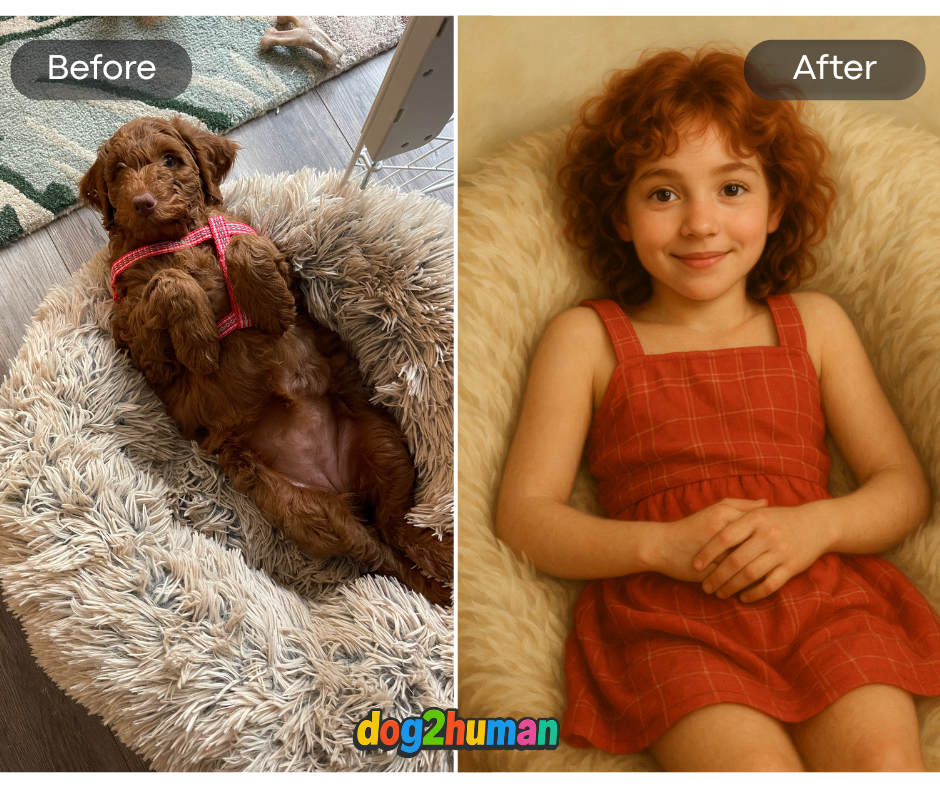What Would My Dog Look Like as a Human? 💭

Have you ever looked into your dog's eyes and wondered, "What would my dog look like as a human?" It's a whimsical thought, but it stems from something profound: the incredibly strong connection we forge with our canine friends. This bond isn't just imaginary; scientific research confirms the unique nature of the human-dog relationship, shaped by tens of thousands of years of cohabitation [1, 2].
The Science Behind the Bond 🧬
Dogs aren't just pets; for many, they are family. Studies show that the dog-human dyad often involves attachment bonds remarkably similar to those between human caregivers and infants [1]. Dogs actively seek proximity to their humans for comfort, especially in stressful situations, exhibiting what researchers call a "safe haven effect" [1]. They even use their owners as a "secure base" to explore new environments more confidently. This deep-seated attachment fuels our tendency to see them as near-equals, individuals with personalities, emotions, and unique quirks.
Communication is key to this bond. Dogs have evolved sophisticated ways to understand us, surpassing even chimpanzees in interpreting human gestures like pointing [1]. They are uniquely attuned to our social cues, including eye contact and tone of voice [3, 4]. This ability to read us allows for a level of companionship rarely seen with other species. Research even suggests that interacting with dogs offers physiological and emotional benefits to humans, reducing stress and promoting well-being [1]. That feeling of love we have for our dogs, sometimes rivaling what we feel for other humans, is rooted in this complex interplay of attachment, communication, and mutual benefit.
Why the Human Transformation? 🤔
So, why the curiosity about seeing them as human? It's a natural extension of this profound connection. When we bond so deeply, we anthropomorphize – we attribute human qualities to them. We see their loyalty, their joy, their occasional grumpiness, and we translate it into human terms. It's fun to imagine how their essence, their spirit, would manifest in human form.
Furthermore, we often observe characteristics that seem translatable. Does your dog's scruffy coat remind you of a certain hairstyle? Does their greying muzzle mirror the wisdom of age? Their distinct demeanor – playful, stoic, anxious – feels like a human personality trait. Even their facial expressions, from a happy "grin" to worried brows, resonate with our own emotional displays [4]. Some studies even explore genetic links between specific dog breeds and social cognitive abilities related to human interaction [5].
There's also the age-old saying (or perhaps observation?) that dogs often resemble their owners. Is it the shared lifestyle, similar energy levels, or something more? Imagining your dog as a human lets you playfully explore this resemblance. Would they share your features? Your style? It's a fun way to consider the traits you both might share.
See the Transformation Yourself! 🐶🧑
Wondering "what would my dog look like as a human?" is more than just a passing fancy; it reflects the deep, scientifically-backed bond we share with our canine companions. Their ability to communicate, form attachments, and even seemingly mirror our traits makes this imaginative leap feel natural.
Ready to turn imagination into a visual? The dog 2 human app uses advanced AI to transform a photo of your beloved dog into a stunning human representation. See how their unique features might translate! It's a fun, fascinating way to celebrate the special bond you share. Download dog 2 human for free on the App Store today and discover your dog's human alter ego!
Try the Dog to Human AI Generator now.
Sources:
- Payne, E., Bennett, P.C., & McGreevy, P.D. (2015). Current perspectives on attachment and bonding in the dog–human dyad. Psychology Research and Behavior Management, 8, 71–79. https://pmc.ncbi.nlm.nih.gov/articles/PMC4348122/
- Thalmann, O., Shapiro, B., Cui, P., et al. (2013). Complete mitochondrial genomes of ancient canids suggest a European origin of domestic dogs. Science, 342(6160), 871–874. https://www.science.org/doi/10.1126/science.1243650
- Kaminski, J., & Nitzschner, M. (2013). Do dogs get the point? A review of dog–human communication ability. Learning and Motivation, 44(4), 294-302. https://doi.org/10.1016/j.lmot.2013.05.001
- Siniscalchi, M., d'Ingeo, S., Minunno, M., & Quaranta, A. (2018). Communication in Dogs. Animals, 8(8), 131. https://www.ncbi.nlm.nih.gov/pmc/articles/PMC6116041/
- Tonoike, A., Otaki, K., Terauchi, G., et al. (2022). Identification of genes associated with human-canine communication in canine evolution. Scientific Reports, 12, 6950. https://www.nature.com/articles/s41598-022-11130-x
